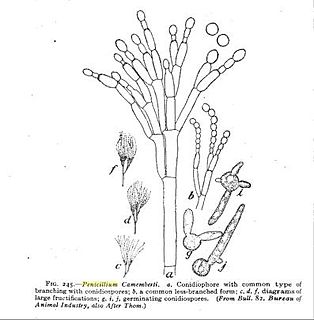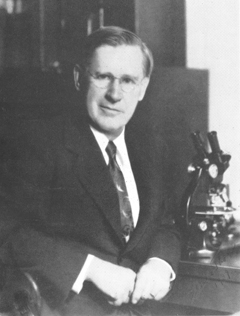
The genus Androstephium is a group of North American plants in the cluster lily subfamily within the asparagus family. It contains two species native to the southwestern and south-central United States.
- Androstephium breviflorumS.Watson - pink funnel lily - deserts of Arizona, Utah, southeastern California, southern Nevada, northwestern New Mexico, western Colorado, southern Wyoming
- Androstephium coeruleum(Scheele) Greene - blue funnel lily - grasslands of Texas, Oklahoma, Kansas

Blue cheese is a general classification of cheeses that have had cultures of the mold Penicillium added so that the final product is spotted or veined throughout with blue mold that carries a distinct smell, either from that or various specially cultivated bacteria. Some blue cheeses are injected with spores before the curds form, and others have spores mixed in with the curds after they form. Blue cheeses are typically aged in a temperature-controlled environment such as a cave. Blue cheese can be eaten by itself or can be spread, crumbled or melted into or over foods.

The Trichocomaceae are a family of fungi in the order Eurotiales. Taxa are saprobes with aggressive colonization strategies, adaptable to extreme environmental conditions. Family members are cosmopolitan in distribution, ubiquitous in soil, and common associates of decaying plant and food material. The family contains some of the most familiar fungi, such as Penicillium and Aspergillus.

Penicillium roqueforti is a common saprotrophic fungus in the genus Penicillium. Widespread in nature, it can be isolated from soil, decaying organic matter, and plants.

Penicillium camemberti is a species of fungus in the genus Penicillium. It is used in the production of Camembert, Brie, Langres, Coulommiers, and Cambozola cheeses, on which colonies of P. camemberti form a hard, white crust. It is responsible for giving these cheeses their distinctive flavors. An allergy to the antibiotic penicillin does not necessarily imply an allergy to cheeses made using P. camemberti.
Chrysovirus is a genus of viruses. It is the only genus in the family Chrysoviridae. They are class III double stranded RNA viruses which infect fungi, in particular Penicillium. Their name is derived from the Greek word chrysos which means yellow-green. There are currently nine species in this genus including the type species Penicillium chrysogenum virus.

The large bamboo rat, Sumatran rat, or Indomalayan rat is a species of rodent in the family Spalacidae found in Cambodia, China, Indonesia, Laos, Malaysia, Myanmar, Thailand, and Vietnam. It is one of four species of bamboo rat. Individuals can reach lengths of nearly 50 cm (20 in) with a 20 cm (7.9 in) tail, and weigh up to 4 kilograms (8.8 lb).
Prophysaon, common name taildropper slugs, is a genus of air-breathing land slugs, terrestrial pulmonate gastropod mollusks in the family Arionidae, the roundback slugs.

Roquefortine C is a mycotoxin that belongs to a class of naturally occurring 2,5-diketopiperazines produced by various fungi, particularly species from the genus Penicillium. It was first isolated from a strain of Penicillium roqueforti, a species commercially used as a source of proteolytic and lipolytic enzymes during maturation of the blue-veined cheeses, Roquefort, Danish Blue, Stilton and Gorgonzola.

Penicillium chrysogenum or P. Notatum (formerly) is a species of fungus in the genus Penicillium. It is common in temperate and subtropical regions and can be found on salted food products, but it is mostly found in indoor environments, especially in damp or water-damaged buildings. It was previously known as Penicillium Notatum. It has rarely been reported as a cause of human disease. It is the source of several β-lactam antibiotics, most significantly penicillin. Other secondary metabolites of P. chrysogenum include roquefortine C, meleagrin, chrysogine, 6-MSA YWA1/melanin, andrastatin A, fungisporin, secalonic acids, sorbicillin, and PR-toxin.

Penicillium brevicompactum is a mould species in the genus Penicillium.

Charles Thom was an American microbiologist and mycologist. Born and raised in Illinois, he received his PhD from the University of Missouri, the first such degree awarded by that institution. He was best known for his work on the microbiology of dairy products and soil fungi, and in particular his research into the genera Aspergillus and Penicillium. His work influenced the establishment of standards for food handling and processing in the USA. He pioneered the use of culture media to grow microorganisms, and, with food chemist James N. Currie, developed a process to mass-produce citric acid using Aspergillus. Thom played an important role in the development of penicillin in World War II.
Tweedia is a genus of flowering plants in the Apocynaceae family, first described as a genus in 1835. The genus is native to South America. An ornamental plant, Oxypetalum coeruleum, formerly included in this genus is commonly referred to as "tweedia".
- Tweedia andina(Phil.) G.H.Rua - Chile
- Tweedia aucaensisG.H. Rua - Argentina
- Tweedia australis(Malme) C. Ezcurra - Argentina
- Tweedia birostrata(Hook. & Arn.) Hook. & Arn. - Chile
- Tweedia brunonisHook. & Arn. - Argentina, Bolivia, Paraguay
- Tweedia echegarayi(Hieron.) Malme - Argentina
- Tweedia solanoides(Hook. & Arn.) Chittenden - Argentina, Brazil, Paraguay, Uruguay
Penicillium alicantinum is a fungus species of the genus of Penicillium which was isolated from the atmosphere in Madrid.
Penicillium vanoranjei is an orange-colored fungus first described in 2013 from specimens collected in Tunisia. It was named after the Prince of Orange Willem-Alexander to commemorate his coronation as King of the Netherlands.
Medicinal fungi are those fungi which produce medically significant metabolites or can be induced to produce such metabolites using biotechnology. The range of medically active compounds that have been identified include antibiotics, anti-cancer drugs, cholesterol inhibitors, psychotropic drugs, immunosuppressants and even fungicides. Although initial discoveries centred on simple moulds of the type that cause spoilage of food, later work identified useful compounds across a wide range of fungi.
Penicillium commune is an indoor fungus belonging to the genus of Penicillium. It is known as one of the most common fungi spoilage moulds on cheese. It also grows on and spoils other foods such as meat products and fat-containing products like nuts and margarine. Cyclopiazonic acid and regulovasine A and B are the most important mycotoxins produced by P. commune. The fungus is the only known species to be able to produce both penitrem A and roquefortine. Although this species does not produce penicillin, it has shown to have anti-pathogenic activity. There are no known plant, animal or human diseases caused by P. commune.

Lasioglossum coeruleum is a species of sweat bee in the family Halictidae.












